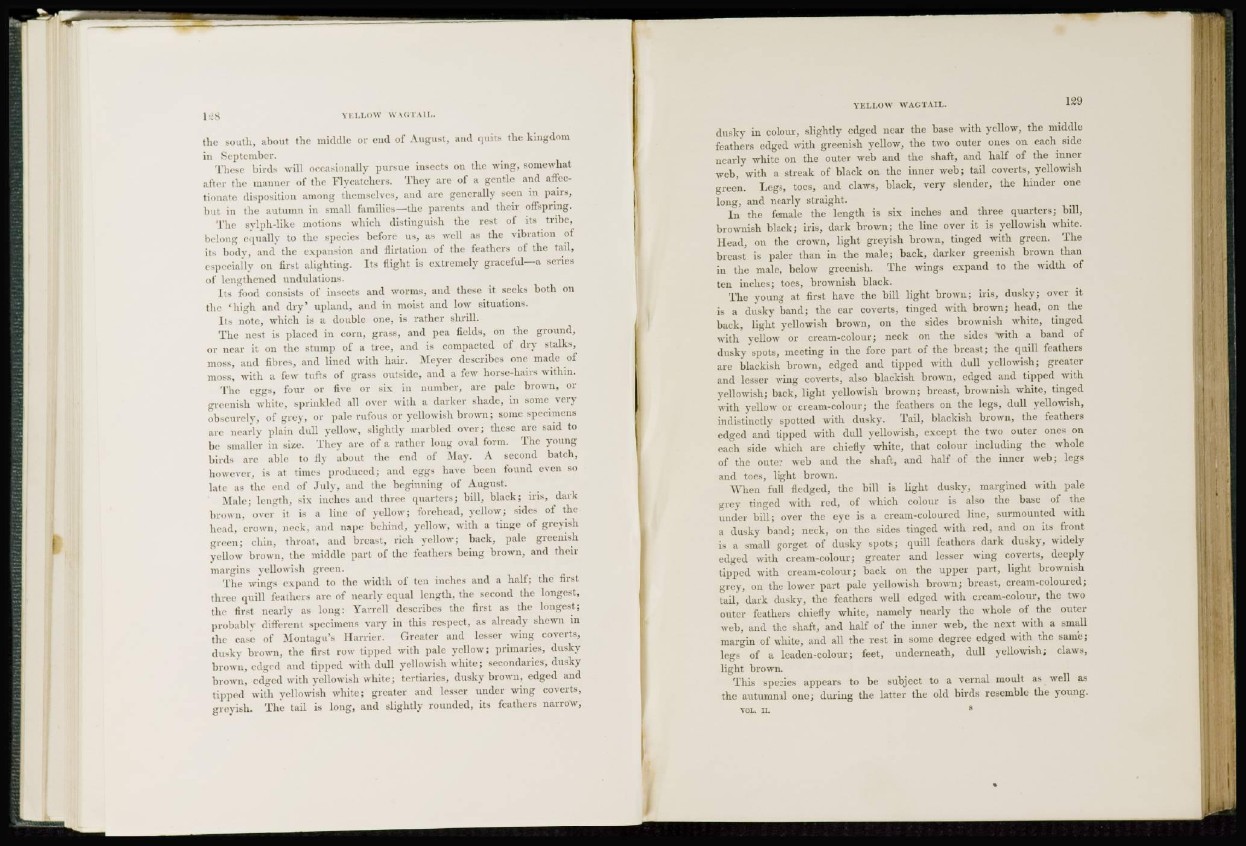
the south, about the middle or end of August, and quits the kingdom
in September.
These bird-, will occasionally pursue insects on the wing, somewhat
after the maimer of the Flycatchers. They are of a gentle and affectionate
disposition among themselves, and are generally seen in pairs,
but in I he autumn in small farniUes—the parents and their offspring.
The sylph-like motions which distinguish the rest of its tribe,
belong equally to the species before us, as well as the vibration of
its body, and the expansion and flirtation of the feathers of the tail,
especially on first alighting. Its flight is extremely graceful—a series
of lengthened undulations.
Its food consists of insects and worms, and these it seeks both on
the 'high and dry' upland, and in moist and low situations.
1\> note, which is a double one, is rather shrill.
The nest is placed in corn, grass, and pea fields, on the ground,
or near it on the stump of a tree, and is compacted of dry stalks,
moss, and fibres, and lined with hair. Mover describes one made of
ninvs, with a few tufts of grass outside, and a few horse-hairs within.
The eggs, four or five or six in number, are pale brown, or
greenish white, sprinkled all over with a darker shade, in seme very
obscurely, of grey, or pale rufous or yellowish brown; some specimens
are nearly plain dull yellow, slightly marbled over; these are said to
he smaller in size. They are of a rather long oval form. The young
birds arc able to fiv about the end of May- A second batch,
however, is at times produced; and eggs have been found even so
late as the end of Julv, and the beginning of August.
Male; length, six Inches and three quarters; bill, black; iris, dark
brown, over it is a line of yellow; forehead, yellow; side* of the
head, crown, neck, and nape behind, yellow, with a tinge of greyish
green; chin, throat, and breast, rich yellow; back, pale greenish
yellow brown, the middle part of the feathers being brown, and their
margins yellowish green.
The wings expand to the width of ten inches and a half; the first
three quill feathers are of nearly equal length, the second the longest,
the first nearly as long: Yarrell describes the first as the longest;
probably different specimens vary in this respect, as already shewn in
the case of Montagu's I Carrier. Greater and lesser wing coverts,
dusky brown, the first row tipped with pale yellow; primaries, dusky
brown, edged and tipped with dull yellowish white; secondaries, dusky
brown, edged with yellowish white; tertiaries, dusky brown, edged and
tipped with yellowish white; greater and lesser under wing coverts,
greyish. The tail is long, and slightly rounded, its feathers narrow,
dusky in colour, slightly edged near the base with yellow, the middle
feathers edged with greenish yellow, the two outer ones on each side
nearly white on the outer web and the shaft, and half of the inner
web, with a streak of black on the inner web; tail coverts, yellowish
green. Legs, toes, and claws, black, very slender, the hinder one
long, and nearly straight.
In the female the length is six inches and three quarters; bill,
brownish black; iris, dark brown; the line over it is yellowish white.
Head, on the crown, light greyish brown, tinged with green. The
breast is paler than in the male; back, darker greenish brown than
in the mah1, below greenish. The wings expand to the width of
ten inches; toes, brownish black.
The young at first have the bill light brown; iris, dusky; over it
is a dusky band; the ear coverts, tinged with brown; head, on the
back, light yellowish brown, on the sides brownish white, tinged
with yellow or cream-colour; neck on the sides with a band of
dusky spots, meeting in the fore part of the breast; the quill feathers
are blackish brown, edged and tipped with dull yellowish; greater
and lesser wing coverts, also blackish brown, edged and tipped with
yellowish; back, light yellowish brown; breast, brownish white, tinged
with yellow or cream-colour; the feathers on the legs, dull yellowish,
indistinctly spotted with dusky. Tail, blackish brown, the feathers
edged and tipped with dull yellowish, except the two outer ones on
each side which are chiefly white, that colour including the whole
of the outer web and the shaft, and half of the inner web; legs
and toes, light brown.
When full fledged, the bill is light dusky, margined with pale
grey tinged with red, of which colour is also the base of the
under bill; over the eye is a cream-coloured line, surmounted with
a dusky band; neck, on the sides tinged with red, and on its front
is a small gorget of dusky spots; quill feathers dark dusky, widely
edged with cream-colour; greater and lesser wing coverts, deeply
tipped with cream-colour; back on the upper part, light brownish
grey, on the lower part pale yellowish brown; breast, cream-coloured;
tail, dark dusky, the feathers well edged with cream-colour, the two
outer feathers chiefly white, namely nearly the whole of the outer
web, and the shaft, and half of the inner web, the next with a small
margin of white, and all the rest in some degree edged with the same;
hg> of a lcadcn-colour; feet, underneath, dull yellowish; claws,
light brown.
This species appears to be subject to a vernal moult a s well as
the autumnal one; dining the latter the old birds resemble the young.